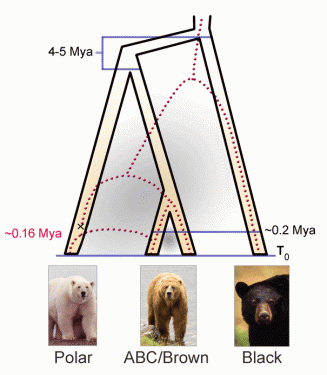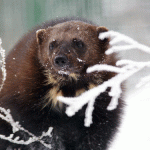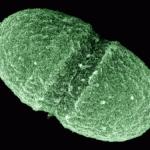
This time climate change could spell doom for polar bears. Image: Yvonne Pijnenburg-Schonewille/Shutterstock.
Polar bear evolution holds clues for past climate change events.
Polar bears have become one of the poster animals for the threat to biodiversity from climate change. However, past climate changes, along with some genes from their brown bear cousins, helped in the evolution of the polar bear as we know it today.
An international research team has tracked polar bear evolution and population size through periods of climate change. “To determine how the polar bears have responded to climate change we need to know how long they have been around as a species and how many existed at various times,” explains professor Webb Miller from Penn State University, co-lead author of the study published in PNAS PLUS.
Using blood and tissue samples from a 120,000-year-old polar bear and some of its modern relatives, the researchers generated genome sequences for polar bears, the brown bear, and the American black bear. They found evidence that the size of the polar bear population fluctuated according to the climatic conditions, growing when it was cooler and shrinking during the warmer periods.
The results also indicated that polar bears have been surviving these changes for much longer than earlier studies have suggested. “Rather than polar bears splitting from brown bears a few hundred thousand years ago, we estimate that the split occurred 4-5 million years ago,” Miller says.
This means it has already survived some warm periods in the past, but it may have had to alter its lifestyle and relationships to do so. The researchers found that the polar bear population shared five to 10 per cent of their DNA with brown bears, suggesting that this interbreeding has also occurred in the past, possibly during climate change events when their ranges overlapped.
“Maybe we’re seeing a hint that in really warm times, polar bears changed their life-style and came into contact, and indeed interbred, with brown bears,” says co-lead author Stephan Schuster from Penn State University.

An analysis of newly sequenced polar bear genomes is providing important clues about the species’ evolution. Image: Penn State University
Unfortunately, four million years of enduring climate changes doesn’t necessarily mean that the polar bear will survive in the future. “I wish I could be confident that this means it can survive another one, but this time more cards are stacked against it,” Miller says.
The authors believe that the genetic diversity of modern polar bears is probably lower than in earlier warm periods, so they may have trouble responding to new conditions. On top of this, temperatures may be increasing faster than ever before, so they would have less time to adapt.






